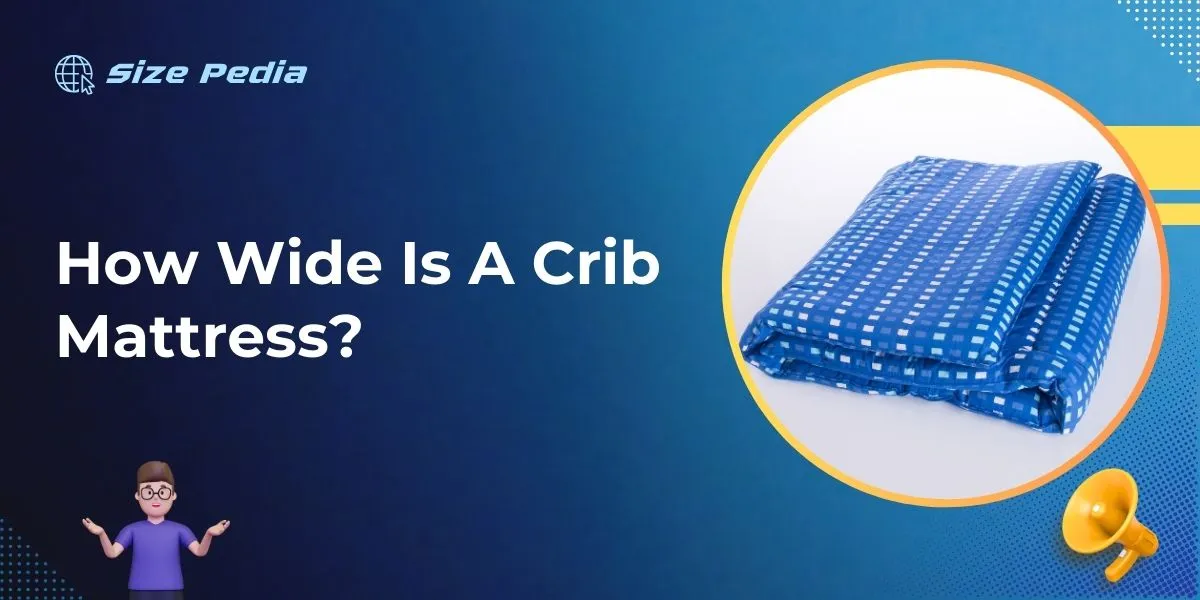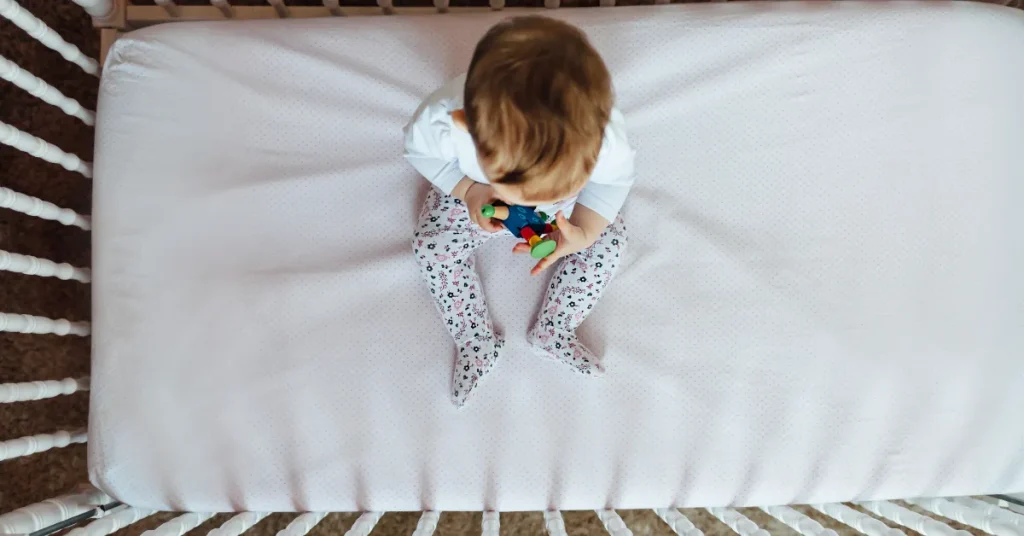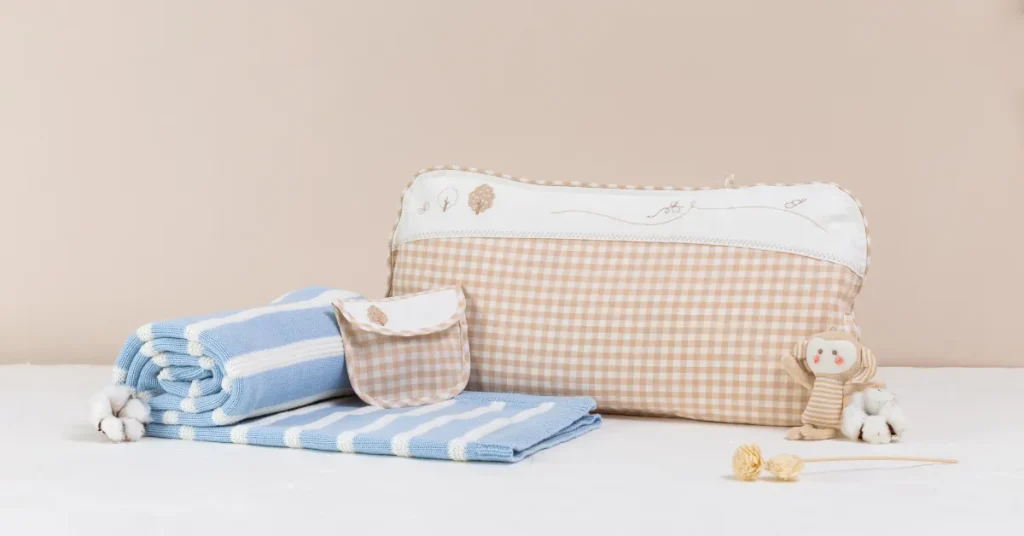A standard crib mattress is approximately 28 inches wide and 52 inches long. The size ensures a snug fit within a full-sized crib for safety and comfort.
Choosing the right crib mattress is essential for the well-being and safety of your infant. Parents and caregivers need to ensure that the crib mattress they select fits properly within the crib frame to prevent any potential hazards.
A well-fitting mattress not only provides a firm surface necessary for an infant’s physical development but also minimizes the risks of suffocation or entrapment.
Proper mattress size also allows for the crib sheets to wrap securely around it, ensuring that the sleeping environment remains as safe and comfortable as possible for your little one.
As you embark on the journey of parenthood, understanding the dimensions and importance of a correctly sized crib mattress will be a cornerstone in creating a nurturing nursery.

Crib Mattress Dimensions
Choosing the right crib mattress is key for your baby’s comfort and safety. The size of the mattress can affect how well it fits in the crib. Let’s look at the usual sizes.
Standard Size Criteria
The standard crib mattress size is regulated to ensure a snug fit inside the crib. This means less risk for babies.
Most crib mattresses are:
- Width: About 28 inches
- Length: Around 52 inches
- Thickness: Up to 6 inches
The standard size is designed to match the interior of most cribs, preventing gaps. This aligns with safety standards.
Variations Across Brands
Different brands may offer slight variations in mattress size. It’s important to check each product.
| Brand | Width | Length | Thickness |
| Brand A | 27.5 inches | 52 inches | 5.5 inches |
| Brand B | 28.5 inches | 52.5 inches | 6 inches |
| Brand C | 28 inches | 51.5 inches | 5 inches |
Always measure the crib’s interior before buying a mattress. This ensures a perfect fit.
Importance Of Proper Sizing
The right size crib mattress is crucial. A well-fitting mattress keeps babies safe. It also adds to their comfort. Let’s explore why sizing is so important.
Safety Considerations
A tight mattress fit prevents hazards.
- Gaps can trap baby limbs.
- Too small a mattress poses falling risks.
- Standard cribs need standard mattresses for safety.
Check for snug corners and edges always.
Comfort For Your Baby
Adequate support ensures better sleep.
- Proper sizing maintains mattress shape.
- Firm surfaces aid development.
A consistent sleep space is key for growth. It helps them sleep well.
Measuring For The Right Fit
Ensuring your baby’s crib mattress fits perfectly is crucial. Not too big, not too small, just right. It’s like fitting a puzzle piece. The right fit keeps baby safe and sound. Now, let’s talk tools and steps to measure a crib mattress.
Tools Needed
Finding the right size starts with the proper tools.
- Tape measure: for precise measurements
- Notebook: to jot down numbers
- Pen or pencil: for recording data
Step-by-step Guide
Follow these steps to ensure a snug fit.
- Empty the crib: Remove bedding and toys.
- Measure length: Place tape measure at one end. Stretch across to the other end. Write this number down.
- Measure width: Now measure side to side. Note this too.
- Compare to standard: Crib mattresses typically measure about 52 inches long and 28 inches wide.
- Check for gaps: No more than two fingers should fit between mattress and crib.
Remember the numbers. When shopping, compare them with mattress tags.
Regulations And Standards

When picking out a crib mattress, safety is a top priority. The width and size of the mattress can impact your baby’s well-being.
Strict regulations and standards exist to ensure that crib mattresses meet specific safety criteria. These safeguard against risks like entrapment or suffocation.
Government Safety Standards
The government sets clear safety standards for crib mattresses to protect infants. The Consumer Product Safety Commission (CPSC) mandates that full-size crib mattresses should be at least 27 1/4 inches wide.
Yet, they must not exceed 28 inches in width. This ensures a snug fit in the crib. It prevents gaps that could trap a baby. A minimum dimension of 51 1/4 inches long and a thickness not exceeding 6 inches is also specified for full-size crib mattresses.
Certifications To Look For
As you shop, certain certifications offer peace of mind about the product’s safety. Here are key seals of approval:
- Greenguard Gold Certification: This confirms the mattress was tested for harmful chemicals and emissions.
- CertiPUR-US®: It shows the foam used is void of harmful chemicals like lead or mercury.
- JPMA (Juvenile Products Manufacturers Association): It indicates that the product meets set safety standards.
Look for these certifications to ensure your baby sleeps on a mattress free from dangerous chemicals and complies with safe sizing standards. Always check the label to confirm these credentials.
Mattress Selection Tips
Choosing the right crib mattress is crucial for your baby’s comfort and safety. The following tips will help you select a high-quality mattress that ensures a good night’s sleep for your little one.
Material Quality
Consider the materials used in a crib mattress. A good mattress should be made of non-toxic, hypoallergenic, and eco-friendly materials.
Look for certifications like GREENGUARD Gold or CertiPUR-US to ensure a safe sleeping environment.
Don’t skimp on quality. A sturdy, high-quality material will support your baby’s growing body and reduce the risk of suffocation.
Longevity And Durability
The durability of a crib mattress is important for safety and cost-effectiveness. Choose a mattress designed to last through the toddler years. This can include features like a water-resistant cover and dual-sided firmness — firm for infants, cushioned for toddlers.
Checklist for Material Quality:
- Non-toxic materials
- Hypoallergenic
- Eco-friendly
- Certifications (e.g., GREENGUARD)
| Feature | Benefit |
| Water-resistant Cover | Easy to clean and maintain |
| Dual-sided Firmness | Adapts to baby’s growth stages |
Accessorizing The Crib Mattress

Accessorizing the crib is a delightful part of preparing for a new baby. Choosing the right crib mattress is just the first step.
Fitting the crib with cozy and secure bedding and aligning it with the nursery’s theme can make all the difference. Let’s explore how to do that with style and safety in mind.
Fitting Sheets And Protectors
The perfect fit for crib sheets is a must for both safety and comfort. Sheets should snugly fit the mattress, ensuring no loose fabric that could pose a risk to your baby. Here’s a simple guide:
- Measure the mattress width and length.
- Check the sheet size on the packaging.
- Opt for sheets with elastic edges all around.
Don’t forget a waterproof mattress protector. It helps keep the mattress clean and dry. Ensure it fits as tightly as the sheets.
Coordinating With Nursery Decor
Match the crib bedding to the nursery theme for a harmonious and inviting environment. Consider these elements:
- Color palette of the room.
- Themes or characters you love.
- Textures that add comfort and warmth.
Include accent pieces like mobiles, wall art, and rugs that complement the crib’s bedding.
FAQs About How Wide Is A Crib Mattress
What Is The Size Of A Crib Mattress?
The standard size of a crib mattress is approximately 28 inches wide by 52 inches long.
Is A Crib Mattress The Same Width As A Twin?
No, a crib mattress is not as wide as a twin mattress. A standard crib mattress typically measures 28 inches by 52 inches, while a twin mattress usually measures 38 inches by 75 inches.
Do All Baby Cribs Have The Same Size Mattress?
No, baby cribs do not all have the same size mattress. Standard crib mattresses typically measure 27. 25 x 51. 625 inches, but dimensions can vary. Always check the crib’s size requirements before buying a mattress.
What Is The Size Of A Standard Crib?
The standard size for a crib is approximately 28 inches by 52 inches. This size is designed to comfortably fit a standard crib mattress.
Conclusion
Understanding the dimensions of crib mattresses is crucial for the safety and comfort of your child. Standard sizes make shopping easier, yet it’s essential to measure for a snug fit.
With this knowledge, you can confidently select the right mattress, ensuring a cozy and secure space for your little one’s peaceful slumber.
